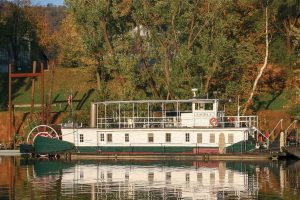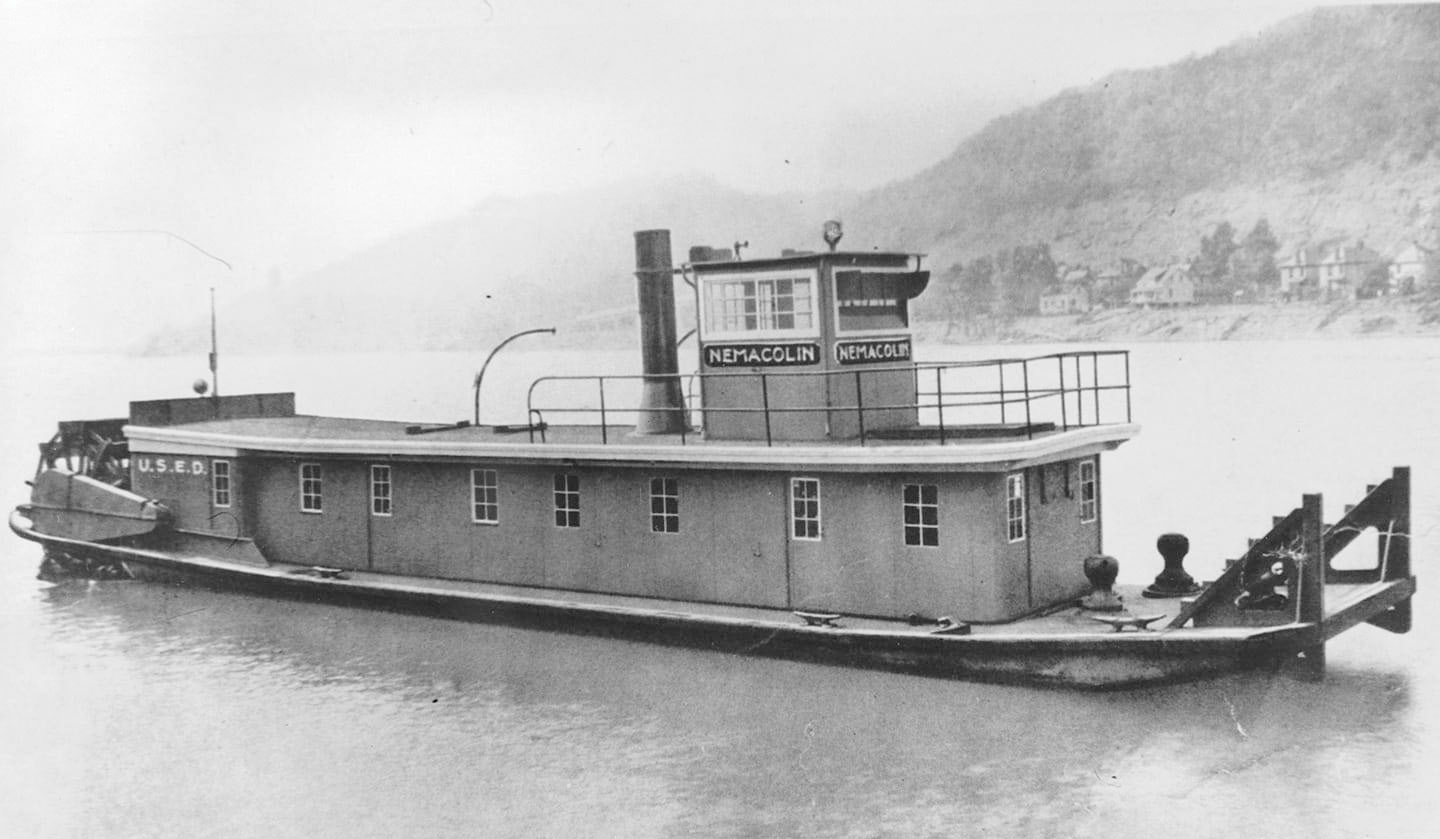The Dravo Contracting Company of Pittsburgh dated back to 1890 and was involved in industrial construction. About 1917, the firm began building floating marine equipment and towboats at a Neville Island, Pa., shipyard at Mile 8 on the Ohio River. After building several steam towboats, Dravo began building a series of small diesel sternwheel boats that would prove to be both popular and versatile.
The first of these boats was built in 1923 and used by Dravo or subsidiary firms. Ultimately, nine of these boats were built (10 if you include the Diesel, with Dravo building the hull and the owners completing the boat). They were all very similar, with steel hulls measuring 70 or 74 feet long and 16 feet wide. All had a steel cabin surmounted by a raised pilothouse with a single smokestack aft of that. A single diesel engine of 100 to 150 hp. powered the sternwheel, and steering was accomplished by use of a traditional wooden pilotwheel linked to the rudders by cable.
In 1929, Dravo completed one of these boats for the U.S. Engineer Department. Named Nemacolin, the boat was listed as having a hull measuring 74.1 feet by 16 feet. It had a Washington diesel engine rated at 100 hp. A photo of it new at Dravo gives an image of a very plain work boat. The Nemacolin was first placed in the Pittsburgh Engineer District and was shown as serving on the Monongahela River.
The engineers assigned the steamer Merrill to the Muskingum River from 1918 until it was sold to Capt. C.C. Stone of Point Pleasant, W.Va., in 1931. Following this sale, according to J. Mack Gamble in his book “Steamboats on the Muskingum,” the engineers’ work on that stream was performed by the Nemacolin and the diesel sternwheel Fort Armstrong, built by Ward at Charleston, W.Va., in 1930. Following their Muskingum service, the paths of these two boats would again cross decades later.
A 1939 photo of the Nemacolin at Lock 14 Ohio River shows it is no longer the drab boat seen new at Dravo in 1929. By 1939, it was painted with a brighter color scheme, handrails had been installed on the cabin bulkheads, and an equipment box could be seen at the front of the pilothouse. By 1941, the Nemacolin was in the Huntington District, and in 1947, the boat was extensively rebuilt at the Engineers’ Marietta (Ohio) Repair Station. In 1949, again at Marietta, the Washington diesel was replaced with a Gray Marine diesel of 225 hp. At some point, the hull was widened some 3 feet by the addition of sponsons.
In April 1954, the boat was declared surplus and sold at a public sale to the J.F. Hardymon Co., Maysville, Ky., and renamed Glenda H. It became a fixture in the Maysville area, shuttling barges of sand and gravel. In 1970, it was sold to Charles T. Jones of Amherst Industries, Charleston, W.Va., and renamed Laura J. Charles T. Jones had been in charge of the river operations for Amherst when it acquired the river fleet of the Hatfield interests and had become a licensed pilot himself.
The boat was used at times to shift barges at the Port Amherst landing on the Kanawha River but was primarily used by Capt. Jones as a means to turn the attention of politicians and business and civic leaders toward the river system. Amherst also had a “whistle barge” with a boiler that supplied steam to blow vintage steam whistles. This “barge” was the hull of the former U.S. Engineers towboat Fort Armstrong that had worked alongside the Nemacolin in the Muskingum River. They were often together once again with the Laura J towing the whistle barge. The boat was again repowered about 1975, this time with a GM 6-71 engine of 165 hp. An awning was place over much of the upper deck area, but otherwise it looked much as it had when built.
In a letter to the editor in The Waterways Journal in November 2018, Mr.

Jones, then 100 years of age, detailed the travels of the Laura J in these endeavors, stating that the boat had “been on every navigable tributary of the Ohio River.” His philosophy in doing this had been to “introduce people to the river so they can see its value and beauty when they otherwise may not have had the experience.” During this time the Laura J was kept up in an impeccable condition, and only the construction style belied her true age.
Following the death of Charles Jones at age 101 in October 2019, the decision was made to sell the Laura J. It went to Capt. Brian Patterson, who lives at Gallipolis Ferry, W.Va. Patterson started working for Amherst immediately upon graduating high school, progressed through the ranks at the company by working in the marine repair and construction divisions and was the director of safety and compliance prior to being named the construction operations manager. Along the way he became a licensed pilot and master.
I have known Brian for many years and saw him at the recent Point Pleasant River Museum dedication. He has restored the original name of Nemacolin to the boat, and it is often seen at area regattas and festivals. Posed the question of how he felt owning such a vessel, his humble answer was that he “was very honored” to own the boat. He went on to say that he was extremely conscious of how the vessel had been represented during the nearly 50 years that Capt. Jones had owned it, and that he now feels the awesome responsibility he has in keeping it up to those standards.
The Nemacolin is now in its 95th year of operation, and it appears to be in safe hands that will steer it into a second century of service.




